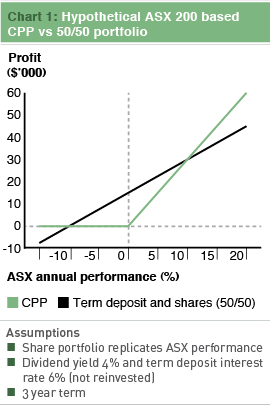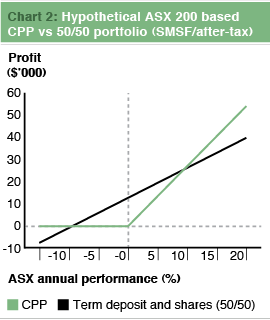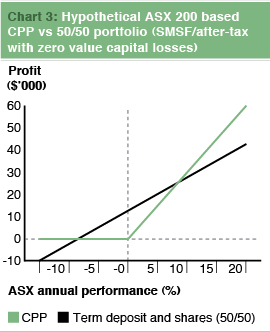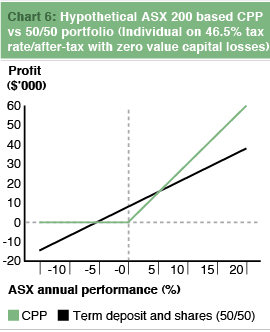Capital protected products: Will the tax benefits save you?
Key Points
- Only in a few cases do tax benefits help alleviate the ‘missing dividends’ problem
- With leveraged products, benefits tend to be offset by the additional cost
- The CPP conundrum still exists but bullish investors with the right attributes have something to think about
The Product
In our earlier article we explained why CPPs were likely to underperform. Movements in the underlying price index don’t provide true share-like returns because you don’t get paid dividends—a larger component of overall performance than most investors think.
By excluding the tax implications of CPPs, this analysis was kept simple. For most people, tax is an irrelevant factor anyway. For the right type of investor, though, it can be a more alluring benefit and therefore a better proposition.
What is the benefit?
The benefit of CPPs is that they pay all their returns in the form of capital gains. Since capital gains qualify for the 50% (individual) or 33% (SMSF) capital gains tax (CGT) discount this can lower the tax burden (relative to interest on a term deposit, for instance). And some investors may have carried forward capital losses that can eliminate CGT completely.
Keep in mind that share price movements will also generate capital gains—and qualify for the same tax benefits—so CPPs only provide a benefit if you consider them as an alternative to holding a high proportion of cash, term deposits or bonds.
SMSFs
If you are investing through an SMSF, tax makes very little difference to the attractiveness of CPPs. SMSFs only get a small CGT discount (10% vs 15%) and a SMSF with carried forward losses (valued by the investor at zero) gets only a 15% pick-up versus paying full freight tax.
Chart 1 (which replicates Chart 3 from the previous article) shows the pre-tax hypothetical performance of a CPP linked to the ASX 200 price index versus a portfolio consisting of 50% term deposits and 50% ASX 200 shares.
Chart 2 shows the after-tax returns for an SMSF (without capital losses). As you can see, there’s little difference to the ‘punt’ being taken. Returns need to be way above (or way below) historical averages for a CPP to make sense.
What if your SMSF has capital losses that are considered worthless? As Chart 3 shows, there’s still not much change to the original analysis.
One of the attractions of SMSFs is that they largely eliminate tax distortions when making investing decisions. This is proven in this case. If you are investing through an SMSF, tax makes little difference to the original proposition: You’re making a bet on returns being significantly different to the historical average.
Companies
Companies pay the same rate of tax on capital gains as they do on ordinary income. There is no CGT discount to change the pre-tax analysis.
However, for those with carried forward capital losses there might be something to think about. If you are prepared to place no value on the capital losses then any capital gain is effectively ‘tax free’.
Chart 4 shows the impact on our analysis. In this case the investor wins if the price index rises or falls by roughly 7% or more. That’s a little more to think about than a SMSF investor, although hardly a conclusive and compelling proposition.
Individuals
In general, individuals on high marginal tax rates will be in a similar position to companies with capital losses. Chart 5 shows the analysis for an individual on the top marginal tax rate (46.5%) entitled to the 50% CGT discount.
As with the company with capital losses, the standard individual needs a 7% rise or fall to win their bet.
Individuals with Capital Losses
This is where it starts to get interesting: High tax rate individuals with bucket-loads of capital losses that have been written off as worthless.
This doesn’t change the fundamental proposition—investors in this category are still betting against history—but the tighter range and ‘pay-off’ for a winning bet changes the landscape.
Chart 6 shows that an individual with a high tax rate and capital losses (valued at zero) will win out if the price index is up or down by roughly 5% a year or more. This is much closer to the historical average (which in the decade we chose—to 31 December 2011—was 2%pa but might be more like 3-4%pa for different periods).
Yes, it’s a bet against history but it’s not out of the question. Why? Because if the investor gets it right the bet pays-off handsomely. If market performance is, say, 15%pa the ‘tax free’ nature of the return makes it a big winner against the 50/50 approach.
The bullish investor might consider this a punt worth taking. But then the bullish investor would get a better result investing in 100% shares: They would have the same gain but the dividends on top.
True, shares don’t come with a capital guarantee—investors avoid the risk of market-based losses with a CPP. If you meet the above criteria, are bullish, but think large index movements (in either direction) are a distinct possibility, a CPP may be worth considering.
Impact of other features
These charts are based on an unleveraged CPP. For leveraged products the additional cost of the debt needs to be factored into the analysis. As a result, the risk/reward equation is less attractive.
Performance caps—where gains are limited—also make it less appealing. The big pay-off if the market performs is what makes a CPP, in this case, worth considering.
Final thoughts
The ‘missing dividends’ problem makes these products expensive. And, for most people, tax won’t help them escape the CPP conundrum.
But if you have the right tax attributes, and a highly distinctive blend of bullishness and nervousness, you might consider giving them a crack.











